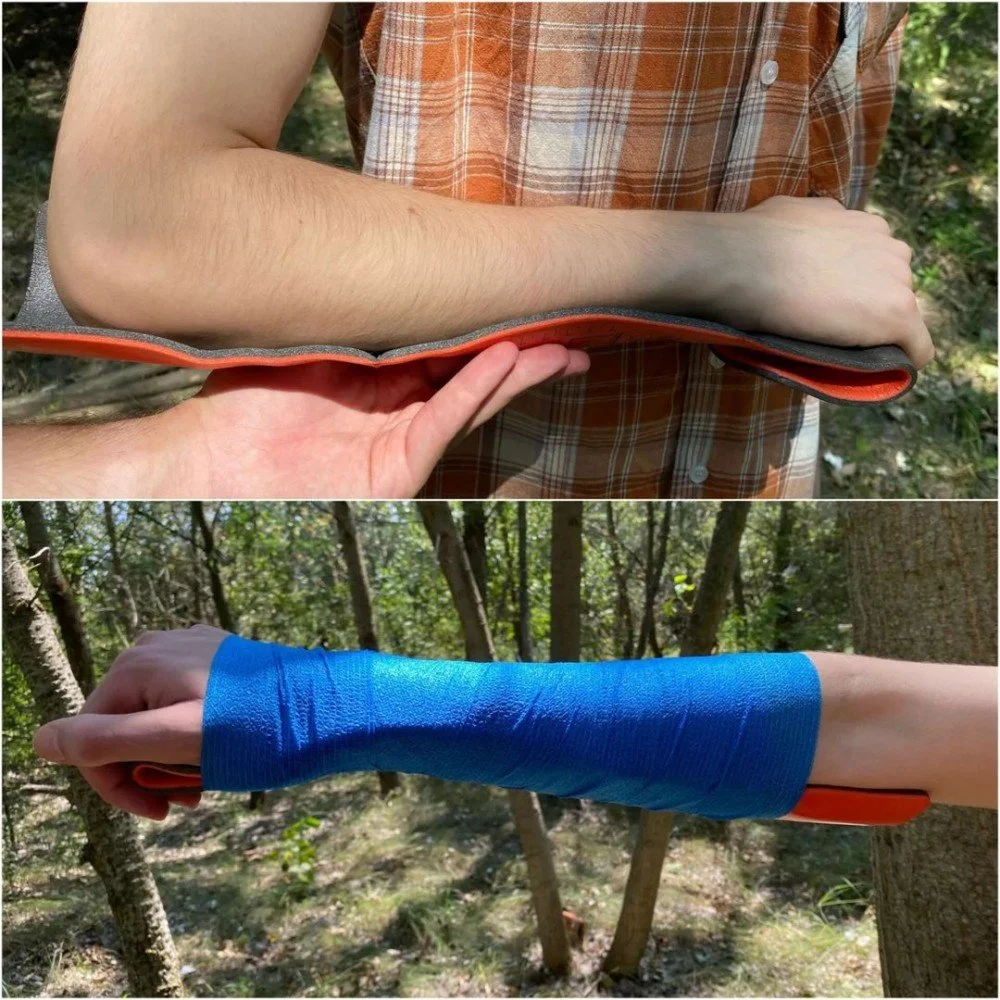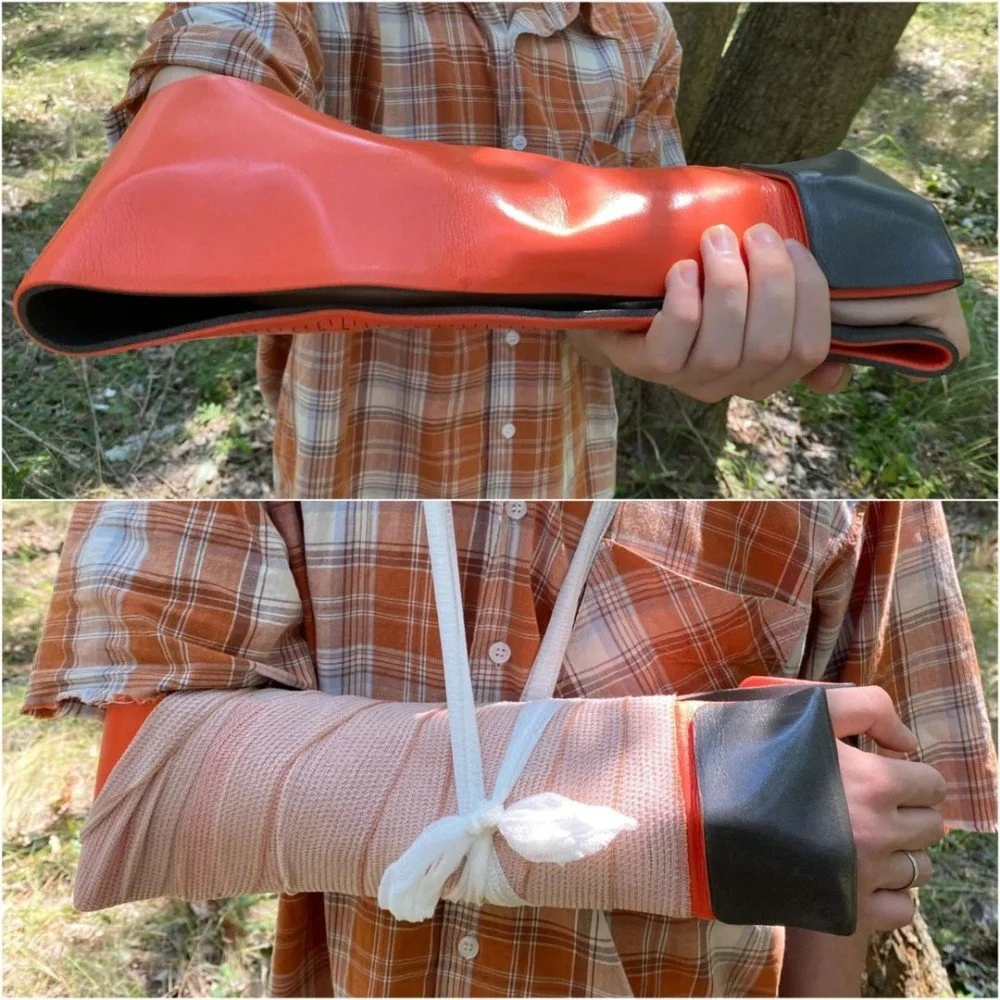Splinting Upper Limb Fractures
The most common fractures are usually the ones sustained by the arm or wrist, most of the time because of falling, sometimes because of blunt force trauma. It's a very common injury, that's why you might have not paid much attention to it in a day to day city life, but in the woods, when you have to be the one stabilizing a fracture, the lack of proper technique might cost you the limb. Do you know how to do it? If not, the rest of this post is addressed to you. (Read the other posts if you want a full understanding of what a fracture is and how to spot one)
Basic universal splinting principles:
immobilize the part above and below the fracture as well
remove any type of clothing or jewellery that might interfere with the splint and/or cause more damage
check for capillary refill and reassess if necessary (>2 seconds refill)
1. Fractured Finger (distal/mid/proximal phalanx)-ideal splint size 3.7 inches.
Remove any rings to prevent further damage caused by swelling (the ring is removed in the lower frame of the picture).
Use your own finger or a casualty's healthy one to form the splint into a, U" shape along its length, it is going to offer proper protection and stability for the injured finger. Place the splint on the affected finger, on the opposite part of the palm (on the knuckle side). For a thumb fracture, place the splint in a similar manner to the boxer's fracture one, but on the radial side.
Use medical tape to fix the splint in place, avoid wrapping the tape directly on the fracture if possible.
Use an elastic bandage to further fix the splint in place
Fractured Finger
2. Boxer's Fracture (4th or 5th metacarpal bone)-ideal splint size 9in
Use the casualty's other hand or your own to mold the splint into a U" shape along its length,
Cover the ulnar side of the hand, starting from the tip of the pinky and covering the wrist. (the splint will look like you karate-chopped it)
Start bandaging from fingers to wrist, leaving the thumb unwrapped, and avoid tying the end of the bandage over the fracture
Boxer's Fracture
3. Wrist Fracture - ideal splint size 9in or 18in
Use the casualty's healthy hand or your own to mould the splint, fold around 3 inches of it for finger support, then mould the rest of it around the wrist as shown in the picture, adjust if necessary
Place the splint on the palm side of the hand with the patient's fingers around the resting nest
Use an elastic bandage to further fix the splint in place, and avoid tying the end directly on the fracture
Apply a sling for increased comfort and stability(if possible)
Wrist Fracture
4. Forearm Fracture (can be used for any regular forearm fracture)- ideal splint size 18in
Use your forearm to mould the splint in a similar manner to the wrist fracture one, but this time the splint is going to extend to the elbow in order to offer proper stabilization of the forearm.
Use an elastic bandage to further fix the splint in place, and avoid tying it directly to the fracture
Apply a sling for increased comfort and stability(if possible)
Apply a swathe (any bandage or piece of cloth used to further immobilize a fracture) to keep the splint and sling close to the body (if possible).
4. Forearm Fracture
5. Double Bone Fracture (I usually prefer to use the sugar tong splint to stabilize a fracture involving both radius and ulna, but it can be used in any situation the regular forearm one can most of the time)- ideal splint size 36in.
Use the casualty's healthy hand to mould the splint in a horizontal U" shape in the middle, then along its length in order to support the forearm, fold around 3 inches for the fingers resting position as in the forearm one.
Use an elastic bandage to wrap the splint in place, avoid tying it directly to the fracture.
Apply a sling for increased comfort and stability (if possible).
Apply a swathe to keep the splint and sling close to the body (if possible).
Double Bone Fracture
6. Humeral Shaft Fracture - ideal splint size 36in.
Use the casualty's healthy arm to create a J shape by folding the splint all around the elbow area, thus forming a 2-layered resting nest for the elbow, and fold the excess material on the shoulder side, then mould the splint in a U shape along its length and around the arm.
The smaller side of the J" shouldn't get much higher than the beginning of the bicep.
The smaller side of the J" should be placed towards the casualty's body.
Use an elastic bandage to further fix the splint in place, avoid tying it directly to the fracture.
Apply a sling for increased comfort and stability(if possible).
Apply a swathe to keep the splint and sling close to the body(if possible).
Humeral Shaft Fracture
7. How to make a sling from a triangular bandage
Ask the casualty to support its injured arm with the palm facing parallel to the ground.
Run one corner of the triangular bandage behind his arm and over his shoulder(uninjured side).
Make sure the arm is centred in the middle of the sling, then run the other corner over the opposite shoulder(injured side) tie a knot(avoid tying it over the injured side), and adjust the sling so that the wrist is slightly above the elbow level.
Twist the excess material at the elbow and stuff it in the sling, this will make it more stable and comfortable.
Apply a swathe to keep the splint and sling close to the body(if possible).
Applying a swathe:
A swathe is any bandage or piece of cloth used to further immobilize a fracture
Wrap the swathe over the injured arm, behind the casualty's back and under the arm on the uninjured side to maximize the stability of the limb
Avoid applying the swathe directly to the fracture
Tie the swathe ends on the uninjured side.
Triangular Bandage
8. How to make an elevation sling (used to control bleeding or to stabilize a clavicular fracture)
Ask the casualty to support the injured arm with the fingers pointing towards the opposite shoulder to the injured hand, with the palm facing the body
Run one corner of the triangular bandage over the shoulder, covering the arm
Run the other corner behind the casualty's back and tie the two corners on the back
Avoid tying the knot directly on the fracture
Twist and fold the excess material from the elbow area
Apply swathe is possible
Normal Capillary Refill (>2 seconds)
Elevation Sling








